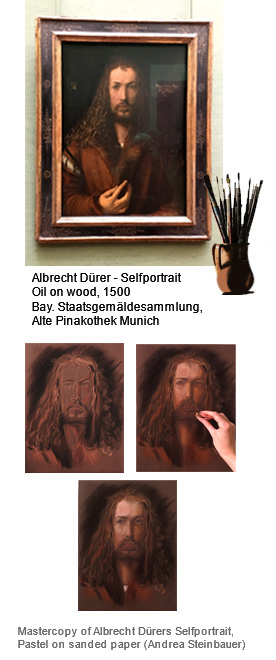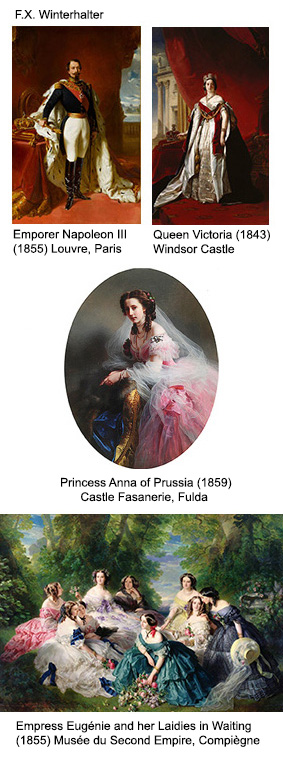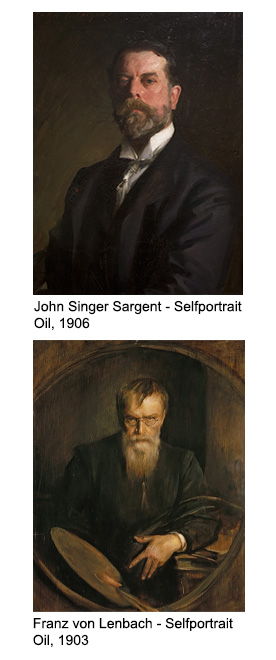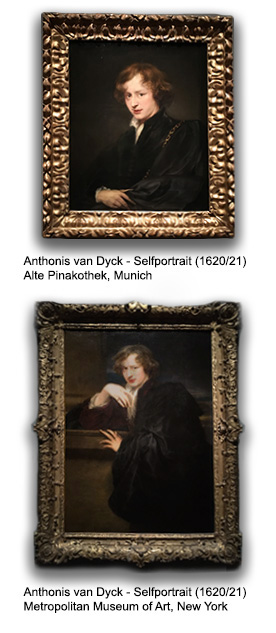 |
|
|
 |
|
|
ArtBlog
|
|
|
|
Albrecht Duerer and the Myth of the Magic Brush
|
|
|
|
 |
As artists, don't we all hope to unveil the secret of a great master or discover a special tool or material that will boost our skill to a higher level, just overnight?
Well, so far in my carrier as an artist I haven't been able to uncover such a secret jet; instead it always has been hard work of practicing and learning to improve step by step.
When thinking about mysterious improvement, I remember an anecdote I once heard about Albrecht Duerer, the great master of the Northern Renaissance. He was famous not only for of his excellent skills in drawing and engraving but also because he could paint hair and fur like no other artist in Europe at that time. According to Dr. Christof Metzger (Head of Curatorial Department, ALBERTINA Vienna), it happened during Duerers time in Italy when the great Venetian master Giovanni Bellini rushed into Duerer's studio in Venice and demanded that the German painter should give him the special brush he uses to paint hair. Duerer responded by grabbing a bunch of brushes and replying to his counterpart: "Take whatever you want; I can do it with any brush." And to reinforce his statement, he randomly took a brush and made a stroke.
Alright, and what is the point of this story? It's the artist who creates the magic and not a mythical tool, special material or secret trick. But we can learn by studying and analyzing the work of masters. This will improve our knowledge and skills, and we will grow, step by step. And just like the old masters, we should always remain curious, and be willing to continue learning to improve, step by step.
|
|
|
Franz Xaver Winterhalter (1805-1873) - Painter in the Order of their Majesties
|
|
|
|
 |
The German artist Franz Xaver Winterhalter was the portrait painter of royalty and aristocrats; from the courts of Europe to Mexico, he painted the nobility of the 19th century. His skill to capture a very personal presence of his sitter, the use of lighting effects, the carefully arranged poses in his composition, the contrast between noble porcelain skin and colorful cloth or accessories, the texture of fabrics and his sense of fashion made him one of the most famous portrait painters of his time.
Beginning of his Career
Born as the son of a farmer in the Black Forest, his talent in drawing was noticed and patronized early and he received a scholarship to study at the Royal Academy of Art in Munich. After leaving the Academy, Winterhalter traveled throughout Italy and joined French artists in Rome, before he moved to Paris. His debut at the Paris Salon Exhibition caught the attention of the French King Louis Philippes and his rise as the painter to royalty begun.
Paris Salon Exhibitions
Winterhalter's Italian genre scenes received great recognition at his Salon debut with Il Dolce Farniente in 1836 and Decamerone was prized in 1837. In 1838, 1842, 1844, and 1863 he participated with portrait paintings. In 1846 Winterhalter commemorated Queen Victoria's 1843 visit to France with a group portrait. His genre painting Florinda, exhibited at the 1853 Salon, was purchased by Queen Victoria as a birthday present for her husband.
Royal Portraits
Winterhalter became a portrait painter at the royal court in France to King Louis Philippes and after the coronation of Napoleon III. He also received commissions from Queen Isabella of Spain, the royal courts of Belgium, Baden and Prussia, Austria, the United Kingdom, Russia and many others. Amongst his best know paintings are the portraits of the iconic Empress Elisabeth of Austria and the French Empress Eugenie.
Winterhalter and Queen Victoria
The young Queen Victoria appointed Winterhalter to the British Court, where he painted numerous portraits of the British Queen, her husband Prince Albert, their children, and members of the royal court. Over more than 20 years, Winterhalter used to visit the Buckingham Palace annual for several weeks and painted more than 120 portraits of the British Royal Family.
Sources:
Alexandra Matzner, ArtinWords, 2016
Paris Salon Exhibitions 1667 - 1880
|
|
|
|
John Singer Sargent (1856-1925) vs. Franz von Lenbach (1836-1904) – Self Portraits
|
|
|
|
 |
The American icon John Singer Sargent and Munich’s ‘painter prince’ Franz von Lenbach both were famous portrait painters during the 19th century.
John Singer Sargent
John Singer Sargent was born in Florence/Italy and spent most of his life in Europe. He studied in Paris, made friends with French impressionist and exhibited at the Paris Salon several times, until his entry of “Madame X” caused a scandal in 1884. After the incident, Sargent left the European continent and moved to London. Supported by his friend, the novelist Henry James, Sargent quickly achieved attention in the United Kingdome and became popular as the portrait painter of wealthy Americans and British society. Until today Sargent is considered to be the best know American portrait painter. In addition to “Madame X”, his most famous paintings are “Carnation, Lily, Lily, Rose”, portraits of Carolus Duran, Henry James and Theodore Roosevelt.
Franz von Lenbach
Franz Lenbach was born in Schrobenhausen, a small village in Bavaria. He studied at the Royal Bavarian Academy of Art in Munich under the legendary instructor Carl von Piloty. Supported by his mentor Piloty and his patron the Baron von Schack, he had residences in Rome and Florence, traveled to Paris, trough Northern Europe and to Spain. After he returned to Munich his rise as a portrait painter of Europe’s nobility and high society begun. Lenbach shaped the image of the admired and socially respected ‘painter prince’ and was awarded with the Order of Merit of the Bavarian crown by King Ludwig II in 1882, giving him the title “Knight Franz of Lenbach”. Amongst his best know paintings are portraits of Otto von Bismark, Emperor Wilhelm I, Emperor Franz Joseph I and Pope Leo XIII.
Self Portraits
In Sargent’s self portrait (1906, oil) his famous direct approach is obviously visible. Using the fewest brushstrokes, no blending and his remarkable edge control are evident in this oil painting. Lenbach’s self portrait (1903, oil) on the other hand, shows well blended brushstrokes and indicates a classical, indirect approach painted in layers. Both painters present themselves in a low key composition with the head in front view focusing their viewers. While Sargent’s painting depicts cool daylight and warm shadows, Lenbach had chosen a warm light source that produced cool shadows. The absence of color on Lenbach’s palette could be an indication that he might have been aware of his passing while he painted his last self portrait.
|
|
|
|
Anthonis Van Dycks (1599-1641)
|
|
|
|
The Flemish Baroque painter Anthonis van Dyck is considered to be the most important portrait painter in the history of art. He painted compelling portraits of aristocrats, military commanders, artists and beautiful women, full of expressiveness and grace. Although he died early at the age of 42, he was able to create an extensive life's work, which fascinates until today.
Van Dyck and Rubens
The carreer of the talented artist began to rise when the worked in the workshop of the great master Peter Paul Rubens. Van Dyck's early artwork was dominated by the influence of his mentor, and he struggled with the overwhelming impact of Rubens. By leaving Antwerp and spending time in England and Italy, van Dyck finally succeeded in finding his own style as an artist.
Selfportraits - Alte Pinakothek/Metropolitan Museum
Van Dycks selfportraits of "Munich's Alte Pinakothek" and "New York's Metropolitan Museum" show many similarities. This became especially obvious when both paintings hung side by side during the 2019 Van Dyck exhibition at the Alte Pinakothek. The "Munich version" appears to be a close up of the "New York version" with a different pose of the hands. Both paintings depict a low key composition with the head in the three-quarters view surrounded by dark background and clothing which contrasts with the light skin tones and the white collar. In the "Munich version" van Dyck also wears a golden chain over his shoulder. Scientific research has shown that the chain was added to the painting later; probably inspired by van Dycks time in Venice after he had grown as an artist.
Sources: Miryam Neumeister, Gemälde von Van Dyck, 2019, Hirmer Verlag
|
|
|
|
 |
|
|
 |
 |
|
|
|
|
|
|
|
|
|
|
|
|
|
|
|
|
|
|
|
|
|
|
|
|
|






